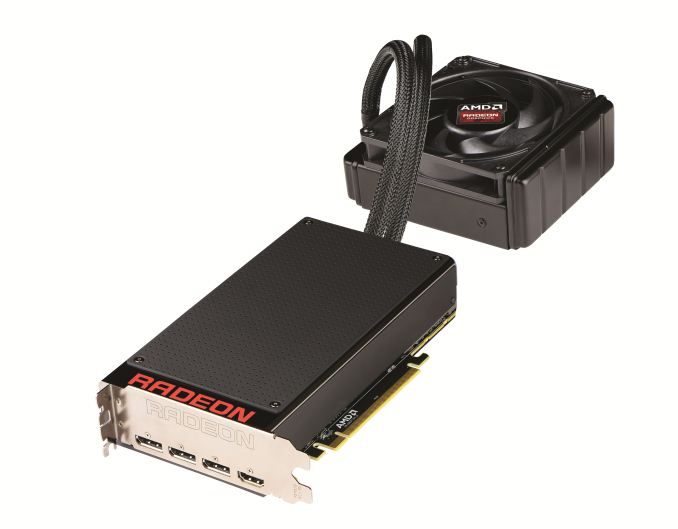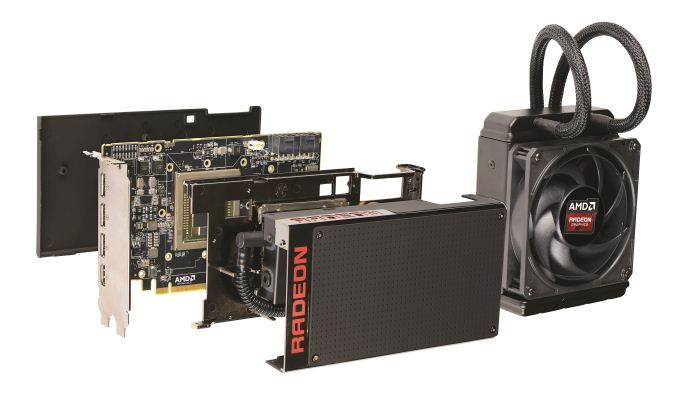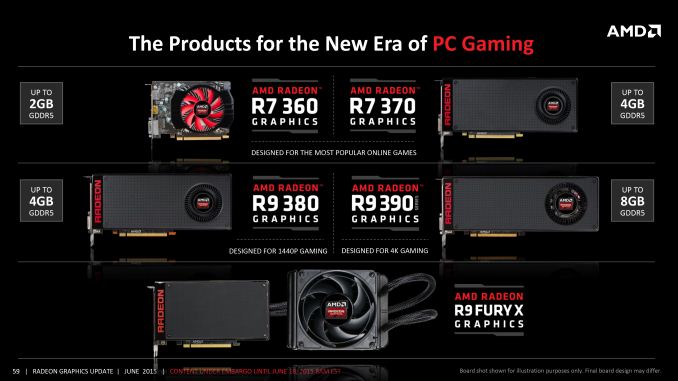AMD Launches Retail Radeon 300 Series: A Prelude To Fury
by Ryan Smith on June 18, 2015 10:35 AM EST- Posted in
- GPUs
- AMD
- Radeon
- Radeon 300

Throughout the last couple of months AMD has been in the process of carefully and deliberately rolling out their latest generation of video cards. In a multi-staged process we have seen AMD engage in a what is best described as a drawn-out teaser and an early technical briefing, announcing their intention to roll out a new high-end video card this quarter, further teasing the public with pictures of the card, and then in the middle of all of that giving the technical press an in-depth briefing on AMD’s key next-generation memory technology, High Bandwidth Memory. While AMD did their best to make sure the details of the cards were kept under wraps – with varying results – AMD definitely wanted to make sure the world would know that their card was coming.
Catching up to the present, earlier this week AMD held their 2015 GPU product showcase, dubbed “The New Era of PC Gaming.” As the latest stage in AMD’s master plan, AMD held a public event in Los Angeles similar to their 2014 GPU product showcase in Hawaii, where the company announced their product lineup ahead of the full launch of the products in question. In the presentation we learned some (but not all) of the details surrounding AMD’s Radeon 300 series, including the numbered products from 360 to 390, and of course the company’s new high-end flagship video card, the Radeon R9 Fury X.
All told the showcase itself was something of a teaser itself – we got prices, but not complete specifications – but we also received confirmation of AMD’s rollout plans. The next stage, coinciding with today’s article, is the formal launch of the numbered members of the Radeon 300 series, which are product refreshes based on existing AMD GPUs, similar to what we saw with the 200 series in 2013. Meanwhile today is also the greater unveiling (but not the launch) of the Fury series, with AMD allowing us to share more details about the new card and its specifications. Following today’s announcements and launches, the Radeon R9 Fury X will be launching in just under a week from now, on June 24th, and then after that the R9 Fury (vanilla) will be launching on July 14th.
| AMD R9 300 Series Specification Comparison | ||||||
| AMD Radeon R9 Fury X | AMD Radeon R9 Fury | AMD Radeon R9 390X | AMD Radeon R9 390 | |||
| Stream Processors | 4096 | (Fewer) | 2816 | 2560 | ||
| Texture Units | 256 | (How much) | 176 | 160 | ||
| ROPs | 64 | (Depnds) | 64 | 64 | ||
| Boost Clock | 1050MHz | (On Yields) | 1050MHz | 1000MHz | ||
| Memory Clock | 1Gbps HBM | (Memory Too) | 5Gbps GDDR5 | 5Gbps GDDR5 | ||
| Memory Bus Width | 4096-bit | 4096-bit | 512-bit | 512-bit | ||
| VRAM | 4GB | 4GB | 8GB | 8GB | ||
| FP64 | 1/16 | 1/16 | 1/8 | 1/8 | ||
| TrueAudio | Y | Y | Y | Y | ||
| Transistor Count | N/A | N/A | 6.2B | 6.2B | ||
| Typical Board Power | 275W | (High) | 275W | 275W | ||
| Manufacturing Process | TSMC 28nm | TSMC 28nm | TSMC 28nm | TSMC 28nm | ||
| Architecture | GCN 1.2 | GCN 1.2 | GCN 1.1 | GCN 1.1 | ||
| GPU | Fiji | Fiji | Hawaii | Hawaii | ||
| Launch Date | 06/24/15 | 07/14/15 | 06/18/15 | 06/18/15 | ||
| Launch Price | $649 | $549 | $429 | $329 | ||
Overall AMD is launching an almost top-to-bottom refresh of its product lineup overnight. Between now and July 14th the company and its partners will introduce cards from $109 to $649, and while there are a few gaps that AMD is almost certainly purposely leaving in place to give them something to announce later this year, overall we’re seeing more or less AMD’s entire hand for 2015 and early 2016 in one go.
As for the subjects at hand today, there are really two stories to talk about. The first is of course the Radeon R9 Fury series, the products that will house AMD’s newest flagship GPU, Fiji. While I won’t butter up Fiji from an architectural standpoint at this time, what Fiji does bring to the table are two very big changes for AMD. The first of these is of course high bandwidth memory, which not only gives AMD more VRAM bandwidth than ever before, but it outright changes how GPUs video cards are constructed. The second big change is that Fiji is just very big. At 596mm2 AMD went right to the reticle limit, putting AMD squarely into the big GPU race.
But before Fury comes the rest of the 300 series. We'll take a look at Fury in due time - while we've been briefed on the subject and have been authorized to discuss it, we want to hold back for when we have the hardware in hand - so our focus for today will be on what's launching today, and that's the Radeon 300 series.
Being released today are five new cards from AMD’s partners, which will form the backbone of the Radeon 300 series from $109 to $429. To our regular readers these parts will be familiar – and to some, perhaps more familiar than they’d like – while for AMD the 300 series represents their 3rd generation of retail 28nm products.













290 Comments
View All Comments
just4U - Thursday, June 18, 2015 - link
While some of the changes have been minor there's enough going on with the 390s to warrant a extensive review and how they stack up against the 970/980. Plus everyone likes "updated" benchmarks to reflect what's currently on the market.. or we'd never get the call to throw in older cards that have been reviewed to death.dragonsqrrl - Thursday, June 18, 2015 - link
I didn't say a review wasn't necessary, I said there probably won't be much to review. As I said in my previous comment, the performance of these cards are known, literally. There's no guess work involved, and there are no surprises coming. The only question in my mind was whether the 300 series uses new revisions of these existing GPUs, but it doesn't look like that's the case.just4U - Thursday, June 18, 2015 - link
I disagree.. looking at benchmarks from early reviews there's certainly some unknowns as the 390x (performance wise..) is a much needed improvement over the 290x and can compete with the 980.. It's vanilla variant (390.. which competes with the 970..) might even be a better solution in Crossfire than two 980s in SLI for 4K gaming which has my interest peaked... what about yours?dragonsqrrl - Thursday, June 18, 2015 - link
No, the performance of the 290X OC'd to ~1.05-1.1 GHz, which has been done many times in the annals of benchmarking history, is very known. And thus you essentially know the performance of the 390X. I guess I could just repeat what I said in my previous 2 comments again, I basically reiterated the same thing 3 times, but they seem easy enough to go back to.And I wouldn't quite call it performance competitive with the 980. To me performance competitive implies trading blows, maybe ~3% behind on avg. Most of the time the 390X seems to fall evenly between the 290X and the 980.
"what about yours?"
No. If your interest wasn't already peaked with the 290/290X, which had a better price/perf ratio for the past ~6 months, why does the 390/390X with an inferior price/perf ratio peak your interest now?
Black Obsidian - Thursday, June 18, 2015 - link
Whether you see the 390X as competitive with the 980 seems to depend on which reviews you read. Guru3D and Hardware Canucks both have the 390X ahead of the 980 in some instances, with the former showing it overall being ~3% slower, and the latter showing it at ~3% faster.At an MSRP $50 lower (which includes custom coolers that are quieter than the nVidia reference blower you're getting at the 980's MSRP), I'd say either of those sites' results qualify as competitive.
dragonsqrrl - Thursday, June 18, 2015 - link
@Black Obsidian I think the 390X is totally competitive at it's price point, but based on the reviews I've seen I wouldn't call it performance competitive with the 980. The Guru3D results are interesting however.And I just realized that the MSI card being tested in all of these reviews uses a tipple slot cooler. Is it even relevant to draw comparisons to this anymore? It's becoming borderline absurd what AMD is having to do just to strive for performance competitiveness at certain price points.
just4U - Thursday, June 18, 2015 - link
The HardOP review suggests competitive as well.. right in line with what any would expect with Amd vs Nvidia Some titles favor one while others favor the other.. which put the cards on equal footing..Until we hit 4k... Standalone the 980 and 390 are adequate (at best depending on your comfort levels) but once you go into 2 card setups the 390 has a edge where it's memory can finally be utilized.. (theory..) so even the vanilla 390s in crossfire might be a better buy over 2 980s.
dragonsqrrl - Thursday, June 18, 2015 - link
@just4U Well, I realized why some of these reviews are showing the 390X getting so close to the the 980. They're using the highest clocked version of the 390X currently available. In fact it's the only version available that doesn't hover around the 1050 stock clock, and it's being measured against stock 980's. The review I referenced on Tom's used an OC'd 980.chizow - Thursday, June 18, 2015 - link
290/X was always competitive with the 970/980 too after AMD slashed prices, people just didn't want old, hot chips with dated feature sets.silverblue - Friday, June 19, 2015 - link
I do love how you keep bringing the heat argument up regardless of the fact that most 290/X cards have aftermarket cooling solutions.There are aspects to DX12 that AMD stands to do better at than NVIDIA. In fact, let's examine this further. In the time that AMD have released one new version of GCN, NVIDIA have launched two versions of Maxwell with differing levels of support - Maxwell 1 is 12_0 compliant, Maxwell 2 is 12_1 compliant. GCN 1.1 (you know, Hawaii) is 12_0 compliant, and came out before Maxwell 1 (about four months, actually).
Resource Binding: Hawaii supports Tier 3, Maxwell 1 supports Tier 2
Tiled Resources: Both support Tier 2
Typed UAV Formats: Hawaii supports Tier 2, Maxwell 1 supports Tier 1
Now, let's compare GCN1.0 and Kepler, both of which are 11_1 compliant (again, GCN1.0 came out before Kepler):
Resource Binding: Tahiti supports Tier 3, Kepler supports Tier 2
Tiled Resources: Tahiti supports Tier 1, Kepler supports Tier 2 (Kepler is therefore ahead here)
Typed UAV Formats: Both support Tier 1
And what about asynchronous compute engines? Here, I'll let AnandTech explain:
http://www.anandtech.com/show/9124/amd-dives-deep-...
Now, you might want to clarify "dated feature sets", especially considering that, Maxwell 2 excepted, AMD has beaten NVIDIA to the punch on DirectX compliance for the past two generations. Morever, we don't actually know what Fiji's complaince level is yet. Additionally, how many people will have bought the 970/980 for its compliance level?